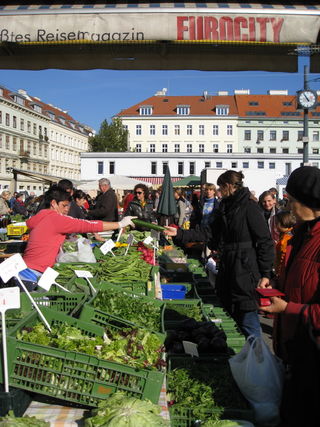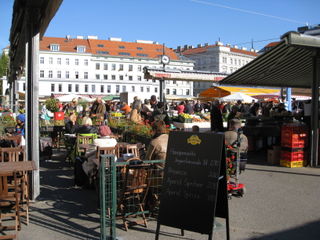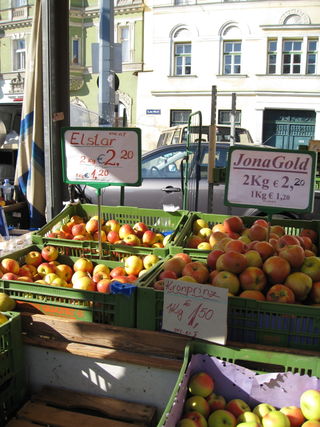 This weekend we visited the Karmelitermarkt .. which translates as Market of the Carmelite nuns... just a
few blocks from our apartment. The market, one of the biggest and best known in Vienna, and dating back to 1671, is in a square about two-blocks-by-two-blocks. It is surrounded on all sides by turn-of-the-century mansions and modern storefronts. It operates everyday except Sunday and features several full-time stores including a half dozen produce markets (many run by families with Slavic names), a couple butcher shops (including one with horse meat), several cafes and eateries, a bunch of konditoreis (pastry shops) and several flower shops.
This weekend we visited the Karmelitermarkt .. which translates as Market of the Carmelite nuns... just a
few blocks from our apartment. The market, one of the biggest and best known in Vienna, and dating back to 1671, is in a square about two-blocks-by-two-blocks. It is surrounded on all sides by turn-of-the-century mansions and modern storefronts. It operates everyday except Sunday and features several full-time stores including a half dozen produce markets (many run by families with Slavic names), a couple butcher shops (including one with horse meat), several cafes and eateries, a bunch of konditoreis (pastry shops) and several flower shops.
But it’s Saturday morning when the Karmeliter markets really shines. That’s when a couple dozen farmers from nearby farming areas set up rickety wooden stands and booths and sell meat, fish, fruits, vegetables, cheese, bread and nuts … all gathered, farmed, raised or produced by their small family operations.
A couple of cafes were bustling already at 9 a.m., with ladies and gents in substantial coats and jackets sitting contentedly in the sun (it was about 55 degrees) and sipping Aperol Spritzes. (Jimmy Buffett may worry if it’s 5 o’clock somewhere, but these folks need no justification for drinking a beer or Spritz at any time of day.)
 Aperol is the Italian aperitif that I blogged about in May when I discovered it in Italy’s northernmost SudTirol region. Made from gentian flowers, rhubarb, bitter orange and the bark of the chichona tree, it’s a beautiful shade of red, with a rich, complex, subtlely sweet flavor. It’s also the hottest cocktail in town, with every sidewalk café, coffee house, bar and restaurant hawking it on chalkboards on the sidewalk. Mixed with sparkling water and, usually, with a splash of prosecco, it’s low in alcohol, refreshing and delicious. Even at 9 in the morning!
Aperol is the Italian aperitif that I blogged about in May when I discovered it in Italy’s northernmost SudTirol region. Made from gentian flowers, rhubarb, bitter orange and the bark of the chichona tree, it’s a beautiful shade of red, with a rich, complex, subtlely sweet flavor. It’s also the hottest cocktail in town, with every sidewalk café, coffee house, bar and restaurant hawking it on chalkboards on the sidewalk. Mixed with sparkling water and, usually, with a splash of prosecco, it’s low in alcohol, refreshing and delicious. Even at 9 in the morning!
On this crisp autumn morning, the market was abuzz with activity and a riot of color, with mounds of apples in different shades of red, orange squashes cut in half and every imaginable type of salad green sharing space with beets, carrots and cauliflower.
As a Californian, I’m always surprised to find better lettuces elsewhere. But I was blown away by the mache (lamb’s lettuce) from one stand. It was unbelievably fresh with a lovely firm texture. We had it in a salad for dinner and I enjoyed the rest the next morning for breakfast on a seeded roll spread with butter and layered with thin slices of 14-month-aged Bergkase (mountain cheese) from Vorarlberg, Austria’s westernmost province. Another treat from the Karmelitermarkt.
There’s still a profusion of squash and pumpkins, but the Eierschwammerln (chanterelle mushrooms) that were everywhere when we arrived 3 weeks ago, are gone. We had planned to have wild mushroom ragout for dinner at home Saturday night. However, only one farm stand had a basket of mushrooms and they were mostly Steinpilze (porcini or cepes), with a few chanterelles mixed it. “That’s all we could find yesterday,” the farmer lady said of her excursion into the nearby woods.
The apples in this part of the world are delicious. Crisp and juicy, with remarkably distinctive flavors, they come in a dozen varieties. The best apples I’ve tasted this month were tucked inside a heavenly strudel made by our friends, Ingrid and Heinz Hueber, who served us the masterpiece at their 300-year old farmhouse outside of Linz (2 hours from Vienna). But I also tasted great apples at the Karmeliter market, notably the Kronprinz (Crown Prince) and the tart Boskoop.
Potatoes, too, are in hefty supply, with dozens of varieties available for the Austrian kitchen’s many soups, stews, roasts, gnocchi, dumplings and strudels. Yup, strudel. We found it at Hauserl am Roan, a charming cafe in the middle of the Wienerwald (Vienna Woods) during a hike on Sunday. The squash and potato strudel was topped with Speck (bacon) sauce and a bit of cheese, run under a broiler and served with a green salad on the side. It could convert every last squash hater on the planet.


Comments